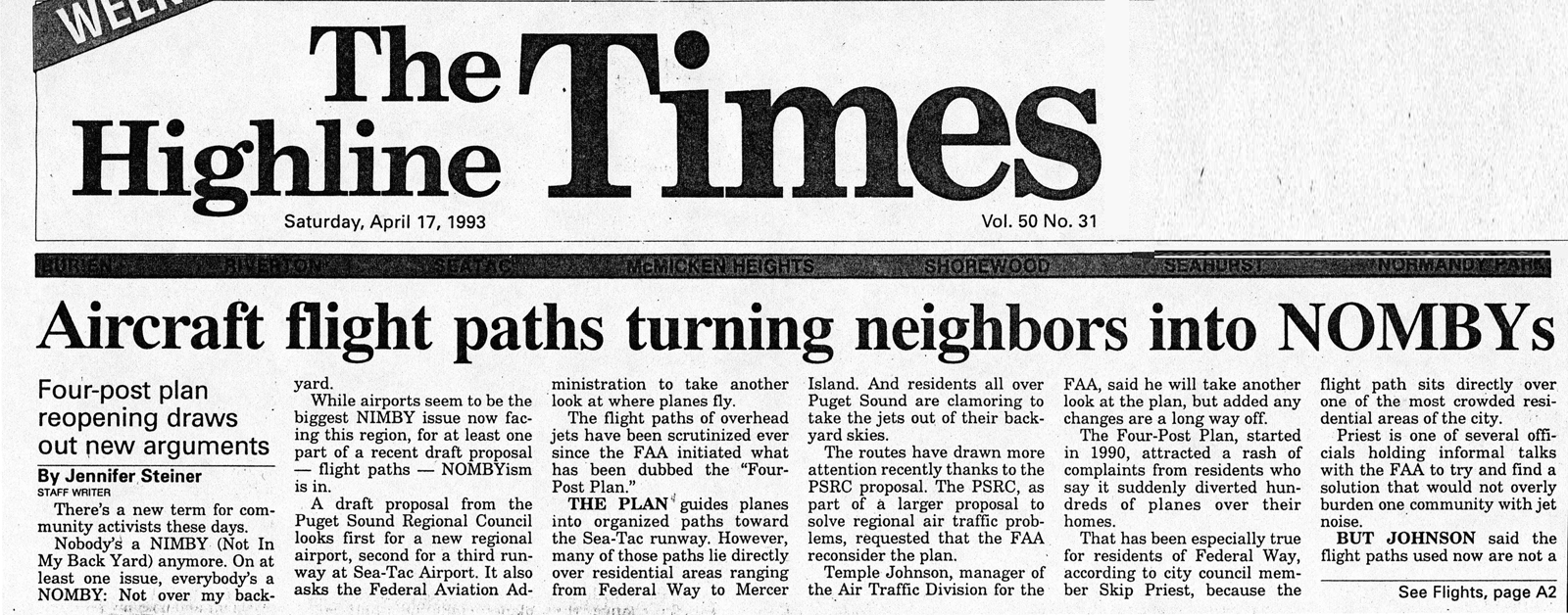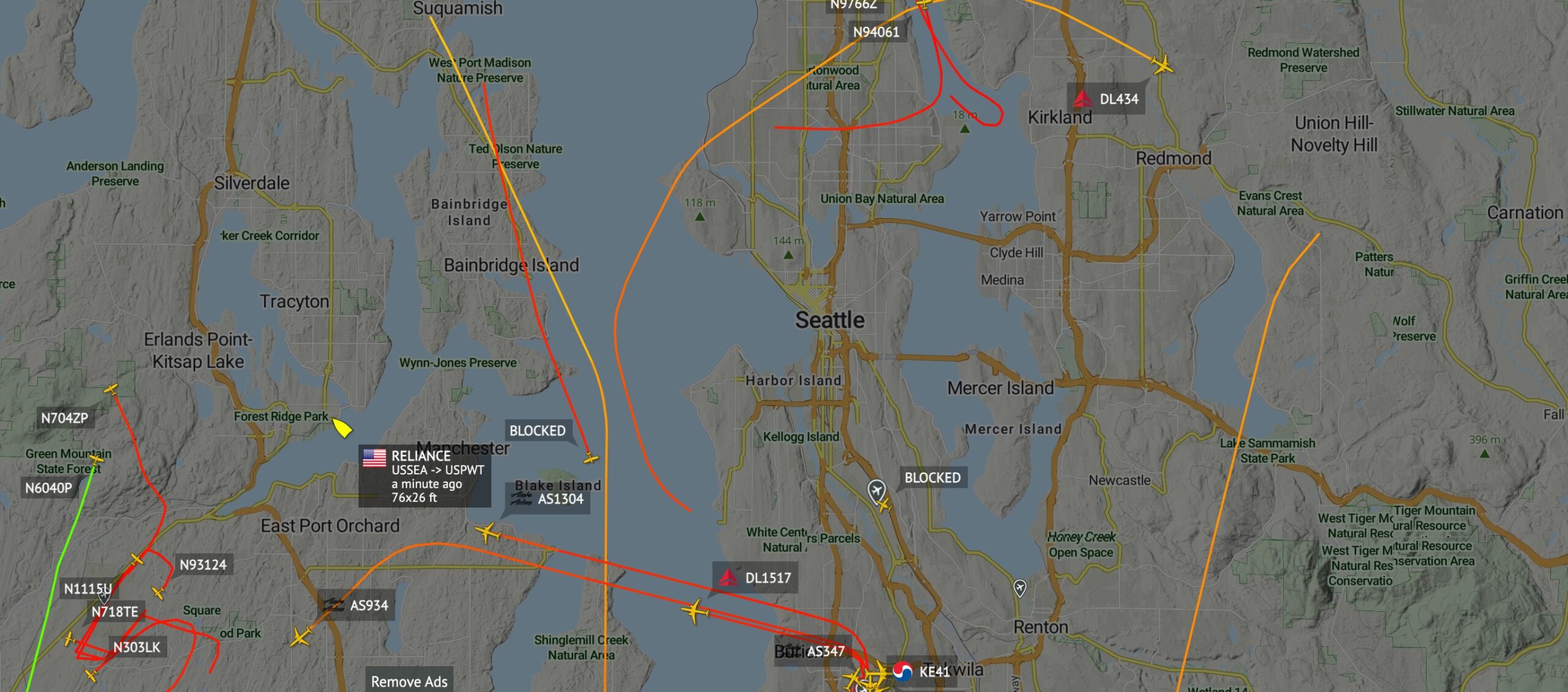Every year in Seattle, there is the SeaFair Festival and that means the return of the Navy’s Blue Angels precision flying team which deploys their show from King County International Airport.

Exciting stuff in more ways than one. For five days that means a dramatic change in flight paths at Sea-Tac Airport, as commercial traffic is diverted towards communities unfamiliar with what people living under the flight path experience the other 360 days of the year.
The real question is this: Is decreasing the noise for the many, worth dramatically increasing the suffering of the few, because (supposedly) ‘they were already used to it’?
Remember the 80’s?
A decade before the Third Runway fight, and after a number of studies, concerning the shared airspace of Puget Sound, the FAA created the bones of the current flight paths; what became known as The Four Post Plan.
Like all changes to flight paths it was controversial, because of course, the plan permanently shifted the pain to people unaccustomed to the constant thrill of aviation. Ironically, this included thousands of people who had migrated south after the Second Runway in 1970, to what is now Federal Way. More than one resident complained, “It’s as if the airplanes seem to follow me wherever I go.”
So to help organize residents, someone tried coining a catch-phrase: NOMBY. Get it? Not ‘NIMBY’, NOMBY… Not. Over. My. Back. Yard.
You can’t make this stuff up…

We’re certain that this was very well-intentioned, but the acronym was, in fact terrible marketing. Because what both newspapers and electeds heard was not so noble as:
“We object to the noise and pollution and other negative impacts!”
What they understood residents to be saying was this:
“We’re totally fine with it. So long as it goes somewhere else.
Which is exactly what residents were saying.
Remember what Spock says while dying?

What people who are not electeds often don’t seem to be realize is that agencies like the FAA represent the people not individuals. Get it? We the people? Government officials are by statute, long training and inclination to be highly biased against NIMBYism.
Instead, governments and agencies are given authority to, tend to be highly biased towards something called “the greater good.”
So if residents argue that their neighborhood should be entitled to be quiet and pollution-free because ‘It was that way when we moved here!’ while having no objection when other areas did not receive the same protections because they have always suffered? That is a total loser for policy makers. Just as with people who object to having their view blocked by a new development? Good luck with that, NIMBY.
Ironically, the FAA’s NextGen policies, which increased efficiency and saved money for airlines, were also intended to reduce noise for the greater good. It increased the suffering for the relative few along the “railroad in the sky”, but concentrating the flight paths made the skies much quieter for many millions more. That may not comforting if you live under the flight path, but it isn’t fake news either.
The real question is this: Is decreasing the noise for the many, worth dramatically increasing the suffering of the few, because (supposedly) ‘they were already used to it’? It’s a real question. The answer is that, for the vast majority of people in America, NextGen has never been a problem–until it threatens to come to their street.
Just like the Blue Angels!
And it gets better. Because currently, the FAA is always exploring even more sophisticated methods of improving flight efficiency with no regard for communities. One, called Wake Recategorization, involves allowing aircraft to essentially fly closer together, front and back, side to side. Just like the Blue Angels!) As in car and bike racing, the follower can ‘draft’ behind the leader to use less energy. Saves fossil fuel. Woo hoo! But at what cost to the people down below when there is literally no break in the noise envelope from one plane to the next?
All politics is localer than you think…
One ugly truth of the Third Runway fight is just how NOMBY people can be. The vast majority of the objections came from people who would now have a runway directly over their heads. But these same people had been mostly complacent for decades about the thousands of people (including the majority of school children) living under the other flight paths.
The ‘Big Lie’ revisited
This is one perfect example. Here is, essentially, the swan song of CASE/RCAA, the two interlocking groups most responsible for opposing the Third Runway. They were able to obtain a one-off public meeting with the Port’s Noise Manager Stan Shepherd, more improbably, the director of FAA Northwest Mountain Dave Soumi, and almost unbelievably the FAA TRACON manager, and also the usual cast of electeds (Tina Orwall, Karen Keiser)

This guy in this 1video is very typical. He’s lived in the area ‘for forty years’. He takes pains to make it clear how much he loves aviation and fully supported the Third Runway. Until it went over his house. And now? He completely understands that it isn’t going away. But still, he wants help. He wants the planes to go somewhere else.
Many of those people feel lied to about the Third Runway (ie. it will only be used in bad weather, etc.) Almost willfully ignoring all the signals from regional planners that the airport would indeed continue to grow.
There is nobody at this meeting talking about capping flights, because, as all the panelists say, that is simply unthinkable. Everyone there is engaging in a form of magical thinking. They want the airport to grow, but they want all the traffic to go somewhere else. And guess what? That is exactly what NextGen does, it concentrates the flight paths, NOMBY.
So if no one is thinking about limiting this system, there is nothing holding back the Port from encouraging both Delta and Alaska to make Sea-Tac their hubs in 2012, which then creates the continuous double-digit annual growth we now experience.
Speaking that TRACON…
Recently, activists mobilized quite successfully to quash any meaningful discussion of a second airport. A movement we fully support–with conditions. Our goal has been to pressure electeds for more help with Sea-Tac Airport, rather than pursue some pipe dream that a second airport will provide us with any relief. However…
Our message to people further South is that it is: just because there is no second airport, does not mean you are protected. As operations increase, you will get more noise and pollution and there will be nothing we can do to help you. If you show no ongoing support for reducing traffic at the source, you get what you deserve. Because although you are outside the tower (six miles) you are still under the TRACON, which extends almost 50 miles. And, as other previously serene areas have found, as operations increase at Sea-Tac, everyone becomes a part of that railroad in the sky.
Equity
In our view, this is a significant reason airport activists have had poorer results than they had hoped. So long as people are, in their hearts, OK with this NIMBY attitude, why should electeds pay them any mind? (After all, you can just move, right?)
If one truly believes in ‘equity’ there are only two ethical options: Share the pain among all neighborhoods, regardless of location or income. Or, fly less and reduce the suffering under the current system.
Actually 2.5 Options…
Since people in the noisy and polluted neighborhoods are absorbing the unrecognized externalities of the airport, it might also be argued that the quiet and clean neighborhoods should be charged a fee to compensate the already damaged communities. Call it a “taking one for the team tax.”
But just telling people to ‘move if you don’t like it’ was always a path towards inequality; a world where quiet and clean air are treated as luxuries one pays for rather than as basic human rights.
Or perhaps you view the world more à la cart? If the public education in your town has declined (perhaps because of an ever-expanding airport)? Again, your answer might be ‘Move’. Or pay for private school. Or filtered air. And water.
More bad news…
There’s also the small matter of climate change. NIMBYs of all types learned long ago that they could use the tools of environmentalists to stop many, many construction projects by insisting on endless ‘studies’ which frustrated developers. This use of NEPA was often disingenuous and that hardened the hearts of many agencies, regardless of political leanings.
But the existential threat of climate change has created a sense of urgency in government. Legislation is on the books (and more is coming) explicitly to make permitting much faster. And that will include airports.
So now we, the airport communities who have counted for decades on those same environmental tools to protect us, will be able to count on them even less. Because (wait for it) the needs of the many… 😀 And this time, the needs of something called ‘the planet’ will outweigh the needs of the few–meaning us.
There will be fixed comment and study periods, regardless of environmental studies. No more seven, eight year wars as with the Third Runway where only a handful of people, armed only with some expertise will be able to hold up mega-projects.
All of which is to say that, whether you live under a flight path, or are freaked out that an airport might be coming to a street near you, NOMBY is no longer a viable strategy. It was also never a particularly ethical approach.
Strategy…
The only winning strategy was always this: cooperation.
If you really want a world that has quiet skies and clean air? Stop thinking like a NOMBY. It will take everyone to change this system. If you’re lucky enough to live in a quiet area, be open to sharing at least some of the pain and compensate those bearing the brunt of the problems you currently do not experience. And above all, stop supporting the current aviation system which uses “the greater good” argument as a way to divide people into two classes: “those who can afford clean air” and “those who cannot.”
1The full meeting video is here and if you want to really feel like resistance is futile, watch the whole thing and cry at how little progress has been made.

I would like to point out that sending planes over rural areas means no person is ever able to escape the city noise. It benefits everyone to keep some areas quiet. It the city there is ambient noises from the population. People in rural areas and people from the city go to rural areas to enjoy quiet, nature, etc. If we send planes over the rural areas because there are “few” people, then no one wins. There will be no more “quiet place” in the world, at this rate – or certainly not the Puget Sound, anyway. No area should be overwhelmed by noise from a plane (that plane is making a profit while making others miserable…) however, I do think there is something to be said for those who knowingly move in near an active airport or highway. Those residents have opted to accept certain things in exchange for others (jet noise for a short commute, for example). However, I also think it is unreasonable to dramatically increase the noise in an area for profit (like planes, highways are a bit more complicated) and expect residents to be okay with that. If I move in next to a guy I know cuts his grass at 7a every Saturday morning, then it isn’t fair to complain about that after I move in, however, if he suddenly starts cutting his grass three times a day, seven days a week…that is a different story. Pretend “me” accepted one level of annoyance but received another – it’s like job creep. If I am hired to move 50 bricks a day for $10 but soon it is 51 bricks and then 52 bricks and after a few months it creeps in and now I am moving 100 bricks a day for that same $10, that is not fair. I knowingly accepted one thing, but the circumstances changed and someone else is profiting at the expense of another. SeaTac’s expected growth of massive numbers can only be achieved with the support of SeaTac/Port authority. They need to stop encouraging, supporting and allowing more and more and more flights out of Washington period. Moving the problem to payne field isn’t the solution. The solution is fewer flights out of the state. The article mentions the 80’s…how did we manage in the 80’s? We don’t needs encourage flying so much – I know people who fly every single week for work…that is unnecessary in so many cases. I know people who commute by plane – literally, every single morning on a jet to PDX and home to SEA after work. SeaTac keeps profiting and sure, creating jobs too but at what cost? The cost of making the entire state a miserable place to live? So, we have a job in a miserable place and live in a miserable place? How does that help anyone? SeaTac needs to make the ambient noise quieter, period. If they can’t find a creative solution to quite the flights, then they need fewer flights, period.
Thank you for your comment. We agree that there should be far less unnecessary flying. However, the rest of the area has only ever shown support for making those reductions when it affected -them-, personally and that is the point of the article. Legislators in areas away from the flight path have consistently refused to help the Sea-Tac communities–until it began to affect -their- constituents. They have consistently insisted that people nearer the airport ‘knew what they were getting themselves into’. Which is not true. This has had the unintended consequence of making the FAA and airport completely unsympathetic to complaints from -everyone-. If you are in a quiet area for now, great. But that is the vicious circle.